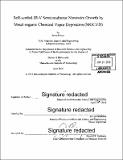Self-seeded II-V semiconductor nanowire growth by metal-organic chemical vapor deposition (MOCVD)
Author(s)
Ermez, Sema
DownloadFull printable version (17.74Mb)
Other Contributors
Massachusetts Institute of Technology. Department of Materials Science and Engineering.
Advisor
Silvija Gradečak.
Terms of use
Metadata
Show full item recordAbstract
III-V semiconductor epitaxial nanowires have gained significant attention in recent years, as they showcase an opportunity to combine III-V material properties with a non-planar morphology. To date, semiconductor devices have been continuously engineered to realize optoelectronic devices with ever smaller size, higher efficiency, and lower power consumption. However, many device improvements have reached fundamental physical limitations. One way to address these challenges is to adapt a non-planar device structure. Nanowires are onedimensional structures that can be grown on a substrate with epitaxial relationship using traditional vapor deposition techniques such as metal-organic chemical vapor deposition (MOCVD). Therefore, the novelty of non-planar morphology can be achieved using industrial scale high throughput deposition techniques. To realize the full potential of nanowires as building blocks in a range of different devices, growth of nanowire arrays with controlled density, morphology, composition and alignment is necessary. In this thesis, we demonstrate controlled growth of self-seeded III-V binary and ternary nanowires by MOCVD. First, self-seeded binary III-V nanowire growth is demonstrated for gallium (Ga)-seeded gallium arsenide (GaAs) nanowires. High yield of vertical nanowires are grown reproducibly by a two-step approach: in situ deposition of Ga seed particles at high temperatures (500°C - 600°C), followed by GaAs nanowire growth at lower temperatures (420°C - 435°C). The fabricated GaAs nanowires show a single crystalline structure at the base and occasional twin planes along the nanowire growth direction. We develop a growth model based on incorporation and extraction of Ga from seed particle to explain the observed tapering of nanowires. Second, control over the density and diameter of nanowire arrays is achieved by controlling seed deposition conditions. We demonstrate that higher seed deposition temperatures or changing the GaAs substrate orientation from (11 )A to (110) and (11 1)B yield reduced areal density and larger nanowire diameters. Seed deposition temperature affects the surface diffusion of Ga adatoms, whereas substrate orientation affects the nucleation of seed particles due to varied chemical potential of Ga adatoms and surface energies on different surface orientations. Lastly, controlled self-seeded ternary III-V nanowire growth is realized in the case of Ga-seeded GaAs1-xPx nanowire growth on GaAs substrates. Composition control for x = 0 - 0.3 and growth of GaP nanowires are demonstrated by varying group-V precursor percentage. It was found that strain due to lattice mismatch between GaAs substrate and GaAsP nanowires can be released due to nanowire geometry. Cathodoluminescence measurements have shown emission of light in GaAsP band gap energies, confirming the successful growth of nanowires in this ternary material system. The methods developed for self-seeded growth of GaAs and GaAsP nanowires, as well as density and diameter control of self-seeded growth are extendable to other self-seeded III-V nanowire material systems.
Description
Thesis: Ph. D., Massachusetts Institute of Technology, Department of Materials Science and Engineering, 2016. Cataloged from PDF version of thesis. Includes bibliographical references (pages 137-143).
Date issued
2016Department
Massachusetts Institute of Technology. Department of Materials Science and EngineeringPublisher
Massachusetts Institute of Technology
Keywords
Materials Science and Engineering.